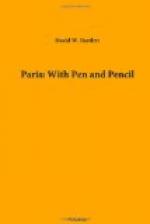The Institut de France lies upon the southern branch of the Seine, just opposite the Louvre, which is north of the river. The Institute is divided into five academies, and the funds which support the institution are managed by a committee of ten members, two from an academy, and the minister of public instruction, who presides over the committee. The academies are—first the Academie Francaise; second, the Academie Royale des Inscriptions et Belle-Lettres; third, the Academie Royale des Sciences; fourth, the Academie Royale des Beaux Arts; and fifth, the Academie Royale des Sciences Morales et Politiques. Members of one academy are eligible to the other four, and each receives a salary of three hundred dollars. The Institute has a library common to the five academies, the whole number of members amounting to two hundred and seventeen. If a member does not attend the proceedings and discussions, and cannot give a good reason for his absence, he is liable to expulsion.
The Academie Francaise consists of forty members, who are devoted to the composition of the dictionary and the purification of the French language. An annual prize is awarded of two thousand francs for poetry, a prize of ten thousand francs for the best work of French history and fifteen hundred francs is given every other year to some deserving but poor student, for his attainments.
The Belle-Lettres Academy is composed of forty members, and ten free academicians—the latter receive no salary. It has many foreign associates or honorary members. Its members pursue the study of the learned languages, antiquities, etc. etc. A yearly prize of ten thousand francs is awarded by it for memoirs, and another for medals.
The Academy of Sciences has sixty-five members, beside ten free academicians. It is divided into eleven sections, as follows: six members are devoted to geometry, six to mechanics, six to astronomy, six to geography and navigation, three to general philosophy, six to chemistry, six to minerology, six to botany, six to rural economy and the veterinary art, six to anatomy and geology, six to medicine and surgery. Prizes are awarded by this academy, yearly, for physical sciences, statistics, physiology, mechanics, improvements in surgery and medicine; for improvements in the art of treating patients, for rendering any art or trade less insalubrious, for discoveries, for mathematical studies, and also a prize to the best scholar in the Polytechnic school.
The Academy of Fine Arts has forty members, who are divided into five sections—painting, sculpture, architecture, engraving, and musical composition. It awards prizes to the best students in the arts, and sends to the French Academy at Rome, free of all expense, the successful students, who are educated at the expense of the state.
The Academy of Sciences Morales et Politiques has thirty members, divided into the following sections: philosophy, moral philosophy, legislation, jurisprudence, political economy, history, and the philosophy of history.




